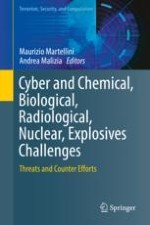This book covers the security and safety of CBRNE assets and management, and illustrates which risks may emerge and how to counter them through an enhanced risk management approach. It also tackles the CBRNE-Cyber threats, their risk mitigation measures and the relevance of raising awareness and education enforcing a CBRNE-Cy security culture. The authors present international instruments and legislation to deal with these threats, for instance the UNSCR1540.
The authors address a multitude of stakeholders, and have a multidisciplinary nature dealing with cross-cutting areas like the convergence of biological and chemical, the development of edging technologies, and in the cyber domain, the impelling risks due to the use of malwares against critical subsystems of CBRN facilities. Examples are provided in this book.
Academicians, diplomats, technicians and engineers working in the chemical, biological, radiological, nuclear, explosive and cyber fields will find this book valuable as a reference. Students studying in these related fields will also find this book useful as a reference.
